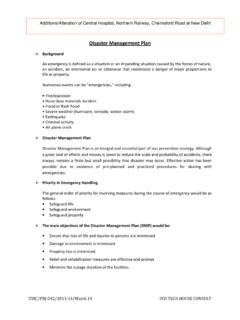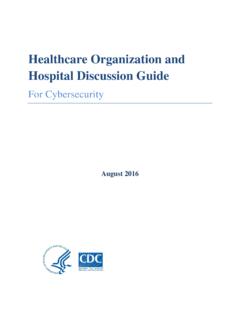Transcription of Post-Discharge Follow-Up Visits and Hospital Utilization ...
1 2014: Volume 4, Number 2. A publication of the Centers for Medicare & Medicaid Services, Office of Information Products & Data Analytics Post-Discharge Follow-Up Visits and Hospital Utilization by Medicare Patients, 2007 2010. Derek DeLia,1 Jian Tong,1 Dorothy Gaboda,1 and Lawrence P. Casalino2. Rutgers University Center for State Health Policy 1. 2. Weill Cornell Medical College Division of Outcomes and Effectiveness Objective: Document trends in time to the largest increase in Follow-Up Visits took place Post-Discharge Follow-Up visit for Medicare between 2008 and 2009.
2 Follow-Up Visits were less patients with an index admission for heart likely for patients who were Black, Hispanic, and failure (HF), acute myocardial infarction (AMI), enrolled in Medicaid or Medicare Advantage, and or community-acquired pneumonia (CAP). they were more likely for patients with greater Determine factors predicting whether the first comorbidities and prior procedures as well as those Post-Discharge Utilization event is a Follow-Up with private or supplemental Medicare coverage. visit , treat-and-release emergency department There were no changes in 30-day readmission rates.
3 (ED) visit , or readmission. Discussion: Although increases in Follow-Up Visits Methods: Using Medicare claims data from may have been inf luenced by the introduction of 2007 2010, we plotted annual cumulative incidence publicly reported readmission rates in 2009, these functions for the time frame Post-Discharge to increases did not continue in 2010 and were not Follow-Up visit , accounting for competing risks associated with a change in readmissions. Patients with censoring at 30 days. We used multinomial who were Black, Hispanic, and/or enrolled in probit regression to determine factors predicting Medicaid or Medicare Advantage were less likely to the probability of first-occurring Post-Discharge have Follow-Up Visits .
4 Utilization events within 30 days. Keywords: Medicare, primary care, health policy, Results: For each cohort, the cumulative incidence politics, law, regulation, quality improvement, report cards of Follow-Up Visits increased during the study (interventions), biostatistical methods, econometrics period. For example, in 2010, of HF patients ISSN: 2159-0354. had a Follow-Up visit within 10 days of discharge compared to in 2007. Within each cohort, doi: DeLia, D., Tong, J., Gaboda, D., et. al. E1. MMRR 2014: Volume 4 (2).
5 Medicare & Medicaid Research Review Introduction 2014: Volume 4, Number 2. Hospital readmission is often used as an indicator of healthcare quality (Benbassat & Taragin, 2000;. Mission Statement Jencks, Williams, & Coleman, 2009; Medicare Medicare & Medicaid Research Review is a peer- Payment Advisory Commission, 2008). Although reviewed, online journal reporting data and research some readmissions are part of a planned course that informs current and future directions of the of treatment or inevitable complications among Medicare, Medicaid, and Children's Health Insurance the most complex patients, others are the result of programs.
6 The journal seeks to examine and evaluate inadequate care during the original Hospital stay health care coverage, quality and access to care for or lack of appropriate community-based Follow-Up beneficiaries, and payment for health services. care after Hospital discharge. Thus, the reduction of excess Hospital readmissions has become a focal point for healthcare delivery reform. The most prominent readmission-based reform is Medicare's Hospital Readmission Reduction Department of Health & Human Services Kathleen Sebelius Program (HRRP).
7 Created under the Patient Secretary Protection and Affordable Care Act (ACA), the HRRP imposes reimbursement penalties Centers for Medicare & Medicaid Services on hospitals that have more than the expected Marilyn Tavenner Administrator amount of 30-day all-cause readmissions for heart failure (HF), acute myocardial infarction (AMI), Editor-in-Chief and community-acquired pneumonia (CAP;. David M. Bott, Centers for Medicare & Medicaid Services, 2013). Readmissions are also targeted by accountable care organizations (ACOs) and the Community-Based The complete list of Editorial Staff and Care Transitions Program, which makes funding Editorial Board members available to hospitals and community-based may be found on the MMRR Web site (click link): organizations to work collaboratively to reduce MMRR Editorial Staff Page readmissions (Centers for Medicare & Medicaid Services, 2011, ).
8 Contact: Although many readmissions are not avoidable (van Walraven et al., 2011; van Walraven, Jennings, & Forster, 2012 ; van Walraven &. Published by the Centers for Medicare & Medicaid Services. Forster, 2013), hospitals can directly prevent some readmissions by ensuring that patients All material in the Medicare & Medicaid Research are fully ready for discharge and understand Review is in the public domain and may be their self-care instructions. Further reduction duplicated without permission. Citation to in readmissions requires the management of source is requested.
9 Transitions from the Hospital to the community DeLia, D., Tong, J., Gaboda, D., et. al. E2. MMRR 2014: Volume 4 (2). and ensuring that patients receive appropriate Reports from the Dartmouth Atlas provide ambulatory Follow-Up care. However, the ecological and qualitative perspectives on the relationship between Post-Discharge Follow-Up availability of Post-Discharge Follow-Up Visits Visits and readmissions is confounded by for Medicare patients. One report found that unmeasured severity of illness. Specifically, the percentage of patients visiting a primary clinicians will often try to ensure that the more care clinician within 14 days of discharge from a severely ill or less stable patients receive a follow- medical admission varied from less than one-third up visit soon after discharge; but these patients in some Hospital Referral Regions to more than are also at higher risk of readmission.
10 Hernandez 60% in others (Goodman, Fisher, & Chang, 2011). et al. (2010) addressed this endogeneity of Another report, based on responses to open-ended Follow-Up Visits for individuals by analyzing interviews of patients and clinicians, uncovered the association between Hospital -level rates of several barriers that prevent access to timely post- Follow-Up Visits within 14 days of discharge and discharge Follow-Up care (Perry, 2013). Patients patient-level likelihood of readmission. They do not always have a Follow-Up appointment found that HF patients discharged from hospitals scheduled before leaving the Hospital and those with higher Follow-Up visit rates were less likely who do may not keep their appointments if they do to experience readmission within 30 days.

















